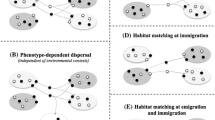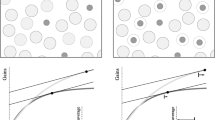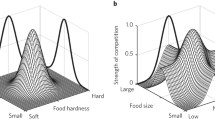Summary
I argue here that, from the perspective of any individual, most landscapes are composed of only three basic types of habitats. These are: (1) source habitat in which reproduction exceeds mortality and the expected per capita growth rate is greater than one; (2) sink habitat, in which limited, reproduction is possible but will not on average, compensate for mortality and the per capita rate of growth is between zero and one; and (3) unusable habitat, which comprises the matrix of all habitats that are never exploited by the species in question, and in which patches of source and sink habitats are embedded. Unlike earlier source-sink models, this model explicitly considers the effects that substituting one type of habitat for another has on the equilibrium size of a population and the interactions between species which can use both source and sink habitats. The model demonstrates that the equilibrium size of a species' population can sometimes be increased by substituting unusable habitat for sink habitat. Thus, even though the average patch quality in the landscape may be decreased, the overall quality of the landscape can increase. For two species with distinct habitat preferences, interactions between species can vary qualitatively as well as quantitatively as a function of the relative abundances of each of the habitat types. The model also shows that the interactions between species are particularly sensitive to the relative costs of moving between patches and sampling patches to determine their quality. Recent fragmentation of natural landscapes may increase the cost of searching for usable (source or sink) patches. Under some conditions, the interspecific interactions may be substantially more negative (competitive) than the interactions that evolved in the original natural landscape, further reducing population sizes and increasing the likelihood of competitive exclusion in fragmented modern landscapes.
Similar content being viewed by others
References
Arcese, P. (1987) Age, intrusion pressure and defence against floaters by territorial male song sparrows.Anim. Behav. 35, 773–85.
Beletsky, L. D. and Orians, G. H. (1987) Territoriality among male red-winged blackbirds II. Removal experiments and site dominance.Behav. Ecol. Sociobiol. 20, 339–50.
Bowers, M. A. and Dooley, J. L. (1991) Landscape composition and the intensity and outcome of two-species competition.Oikos 60, 180–86.
Brown, J. L. (1969) The buffer effect and productivity in tit populations.Am. Nat. 103, 347–54.
Cooper, W. E. Jr. and Vitt, L. J. (1987) Deferred agonistic behavior in a long-lived scincid lizardEumeces laticeps. Field and laboratory data on the roles of body size and residence in, agonistic strategy.Oecologia 72, 321–6.
Danielson, B. J. (1991) Communities on a landscape: the influence of habitat heterogeneity on the interactions between species.Am. Nat. 138, 1105–20.
Danielson, B. J. and Gaines, M. S. (1987) The influences of conspecific and heterospecific residents on colonization.Ecology 68, 1778–84.
Dunning, J. B., Danielson, B. J. and Pulliam, H. R. (1992) Ecological processes that affect populations in complex landscapes. (Oikos (in press).
Eden, S. F. (1987) Dispersal and competitive ability in the magpie: an experimental study.Anim. Behav. 35, 764–72.
Fretwell, S. D. and Lucas, H. L. (1970) On territorial behaviour and other factors influencing habitat distribution in birds.Acta Biotheor. 19, 16–36.
Gleason, P. E., Michael, S. D. and Christian, J. J. (1980) Aggressive behavior during the reproductive cycle of femalePeromyscus leucopus: effects of encounter site.Behav. and Neurol. Biol. 29, 506–11.
Grant, P. R. (1972) Interspecific competition among rodents.Ann. Rev. Ecol. Syst. 3, 29–106.
Hammerstein, P. (1981) The role of asymmetries in animal contests.Anim. Behav. 29, 193–205.
Johnson, M. L. and Gaines, M. S. (1990) Evolution of dispersal: theoretical models and empirical tests using birds and mammals.Ann. Rev. Ecol. Syst. 21, 449–80.
Metzgar, L. H. (1967) An experimental comparison of screech owl predation on resident and transient white-footed mice (Peromyscus leucopus).J. Mamm. 48, 387–91.
Morris, D. W. (1992) Habitat selection and patch size in heterogeneous prairie landscapes.Evol. Ecol. 6, 412–32.
Morris, D. W. (1988) Habitat-dependent population regulation and community structure.Evol. Ecol. 2, 253–69.
Morris, R. D. (1969) Competitive exclusion betweenMicrotus andClethrionomys in the aspen parkland of Saskatchewan.J. Mamm. 50 291–301.
Pimm, S. L. and Rosenzweig, M. L. (1981) Competitors and habitat use.Oikos 37, 1–6.
Pulliam, H. R. (1988) Sources, sinks, and population regulation.Am. Nat. 132, 652–61.
Pulliam, H. R. and Danielson, B. J. (1991) Sources, sinks, and habitat selection: a landscape perspective on population dynamics.Am. Nat. 137, S50-S66.
Rosenzweig, M. L. (1981) A theory of habitat selection.Ecology 62, 327–35.
Rosenzweig, M. L. (1985) Some theoretical aspects of habitat selection. InHabitat Selection in Birds, pp. 517–40. Academic Press, London, UK.
Smith, S. M. (1978) The ‘underworld’ in a territorial tree sparrow: adaptive strategy for floaters.Am. Nat. 112, 571–82.
Van Horne, B. (1983) Density as a misleading indicator of habitat quality.J. Wildl. Management 47, 893–901.
Wolff, J. O., Freeburg, M. H., and Dueser, R. D. (1983) Interspecific territoriality in two species ofPeromyscus (Rodentia: Cricetidae).Behav. Ecol. Sociobiol. 12, 237–42.
Author information
Authors and Affiliations
Rights and permissions
About this article
Cite this article
Danielson, B.J. Habitat selection, interspecific interactions and landscape composition. Evol Ecol 6, 399–411 (1992). https://doi.org/10.1007/BF02270700
Issue Date:
DOI: https://doi.org/10.1007/BF02270700




